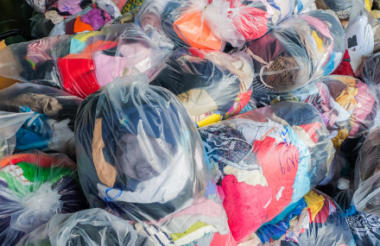Three months ago this week, we were all coming to terms with the UK’s lockdown. Many activities were put on hold as we stayed at home. Among those still possible was searching through wardrobes and chests-of-drawers to clear out all of those clothes, shoes or other textiles we never really wanted.
But it was a spring-cleaning cul-de-sac because the most popular outlets, local charity shops and household waste recycling centres, were closed or, if the latter, offering severely restricted services. Apart from the very few fly-tippers amongst us, the options were either to squirrel away the bags at home or (with a disregard for sustainability) put the unwanted textiles in the general rubbish for collection.
Survey predicts unprecedented volume of clothing for charity shops
WRAP is now able to estimate the size of the likely clothing mountain looming over charity shops, clothing collectors and local authorities. It’s huge.
A survey carried out by WRAP provides charities and textile recyclers with useful insights as we emerge from lockdown.
The responses from 2,422 UK adults during late May reveal that two in every five citizens have had a clear out during lockdown. A fifth of those who did so each amassed more than 20 items of clothing while two-fifths found at least four pairs of shoes they no longer wanted. In fact, our data shows a grand total of 184 million textile items were set aside, including 67 million items of clothing and around 57% of these items are still at home waiting to be disposed of. But for how much longer? And what of the implications when our caches are returned?
Two-thirds of those responding to the survey indicated they wanted to donate them to charity. What that will mean for charity shops in particular is an unprecedented volume of clothing being carried across their thresholds in a relatively short time period. The initial challenge will be for the shop volunteers to receive these donations and then sort them.
There will consequently be problems of storing so much material that might be hard to sell on, particularly as some customers might shy away from the physical high street. Online sales might further compound the charity shop option. It is one reason why WRAP has asked retailers who are signatories of the Sustainable Clothing Action Plan (SCAP) to encourage more shoppers to donate textiles through the often-underused route of in-store collections. It’d certainly help to reduce that mountain. WRAP has also produced advice for people wishing to donate and this is being promoted through its Love Your Clothes campaign.
The partnership between the charities and the textile recyclers over a number of decades is being severely challenged by this added pressure of supply and demand. In the immediate future, there’s going to be too much material and not enough outlets. This is not merely a UK concern. Textile recyclers in the UK have found considerable difficulty in reaching traditional export markets for used clothing, which were already proving difficult to penetrate. Some have been closed directly because of coronavirus-prompted bans on imports, related restrictions or to prioritise the domestic market.
This is having a major impact on international supply chains and the Textiles Recycling Association says its members are now in a completely different economic situation. Indeed, it has warned charity shops and local authorities that payment for collected clothing is increasingly unlikely as end markets are so restricted.
This is potentially of serious concern to that part of the charity sector that generates revenue by taking in donated used clothing. They will always be able to sell on the very best of the unwanted garments but are unlikely to benefit as readily from the export market or that for rags in the immediate future.
Light at the end of the tunnel
There is some light, though, at the end of this particular tunnel. The survey also found that one in five citizens think differently about clothing – either its purchase or disposal. Of these, nearly 30% said they now realise they don’t need as many clothes and 18% want to donate more to charity.
Three months on from the imposition of lockdown, we have all developed different behaviours. For example, another WRAP survey shows that UK citizens have reported a 34% drop in the amount of food they throw away at home. I’m confident that three months is a substantial enough period for some of these new behaviours to stick. In the coming months, WRAP will be developing the next phase of SCAP and these ‘new learnings’ will be highly relevant.
Everyone can play a role in supporting charity shops and and the textile reuse and recycling sector. There may be tough months ahead but the longer-term role for charities in a more sustainably tuned economy is a goal to be prized.
Peter Maddox is director at WRAP UK
Related articles











